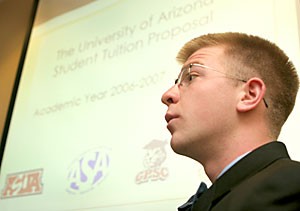Student officials proposed tuition increases nearly identical to those in the UA president’s proposal yesterday, except for in-state graduate students’ tuition, which was half of the president’s.
The Graduate and Professional Student Council, the Arizona Students’ Association and the Associated Students of the University of Arizona proposed that in-state tuition increase by 4 percent and out-of-state tuition rise 9 percent for both undergraduate and graduate students starting the next academic year.
President Peter Likins also released his proposal yesterday. The only major difference was that in the president’s proposal, in-state graduate tuition would increase by 5 percent more than in the students’ plan.
Under the students’ plan, undergraduate resident students would dish out an extra $176, increasing their tuition to $4,570, while in-state graduate students would pay $194 more, bringing their tuition to $5,042.
According to the proposal, out-of-state undergraduates would pay an additional $1,222 increasing their tuition to $14,800, whereas nonresident graduate students would pay an extra $1,245, increasing their tuition to $15,073.
The UA would gain $6.5 million in tuition dollars after the gross tuition revenue and waivers are deducted, according to the plan.
The ASUA senate unanimously approved the student tuition proposal in a special meeting yesterday except for one senator, Ryan Montana Erickson, who abstained from the vote.
The nonresident-student tuition increase is needed to keep pace with public institutions nationwide, said ASA Director Fernando Ascencio.
ASA tries to keep tuition under the top 50 percent of those institutions, which is fair if the UA maintains its current 15 percent financial aid set aside to out-of-state students, Ascencio said.
Invoking the UA’s history as a public land-grant institution, ASA directors said they want to assure student tuition is at its lowest price or “”nearly free as possible,”” Ascencio said.
“”We’re trying to protect all levels of education,”” said Ascencio, a political science senior. “”All resident students deserve affordable education, and we want to make sure affordability isn’t a hindrance.””
ASA identified six priorities as important and identifiable needs for student investment as the cost of education continues to increase.
For graduate students, the fact that the proposed percentage of tuition increase for undergraduate and graduate students are the same this year is pleasing because the numbers haven’t always been proportionate.
“”Education is a great social equalizer,”” said Paul Thorn, GPSC vice president of external affairs. “”Having an attainable amount to pay every year gives all students the ability to be on an equal playing field.””
ASA Director Chris Dang said he predicts a significant rise in financial aid to the tune of $7 million to $10 million. He plans to lobby for student-based need next month before the final tuition amount is set in March.
“”We’re paying the bill, so we should receive some sort of benefit,”” Dang said.
Last year, ASA proposed an 8 percent increase or $320 for undergraduate residents, an increase of $252 for the 2007 fiscal year. An increase of 10.1 percent or $430 was proposed for residential graduate students, a boost of $364 for the 2007 fiscal year.
The nonresident undergraduate proposal last year stood at a 3.1 percent increase or $405, a swell of $1,417 for the 2007 fiscal year. Nonresident graduate proposals stood at a 3.3 percent increase or $430, an increase of $1,415 for the 2007 fiscal year.
Ben Graff, voting student regent for the Arizona Board of Regents, said students need to keep a close eye on tuition and fee increases, which usually affect financial aid compensation.
“”You hope you can fully support the student proposals or at least find a compromise for it,”” Graff said. “”It’s time to address the need for some of these tuition dollars to hit on the class availability issue.””
The directors said each of them had different perspectives during the yearlong proposal process on how much tuition should increase and where that money should be allocated.
“”We tried to make sure our tuition proposal was from the perspective of the students, but that also made sense to the administration,”” said ASA Director Andrew Record. “”It’s good to have all levels of student government to have a hand in this proposal.
Both Likins’ and students’ proposals will be discussed and studied by the administration until Feb. 27, at which time students will have the opportunity to give recommendations to the board of regents about the proposal at a special tuition hearing.
The board of regents is scheduled to meet March 9 and decide the fate of tuition, Record said.









